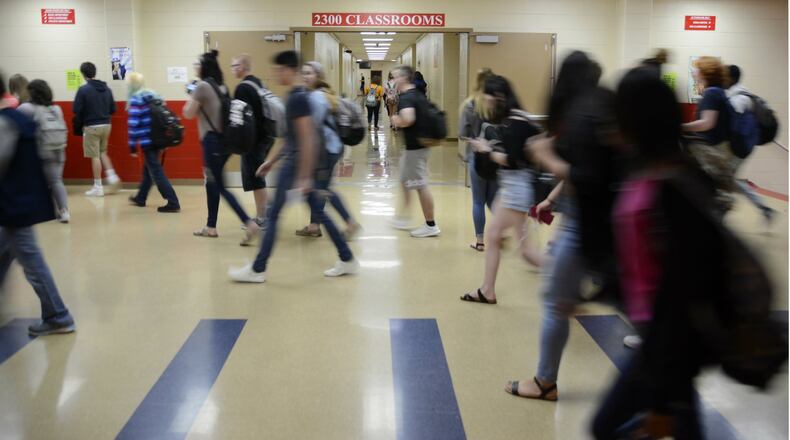It’s important for older students to hear a consistent message directly from other students after, in the elementary school grades, having prevention seeds planted with programs such as Drug Abuse Resistance Education, officials said. All of those pieces are part of the ongoing struggle to keep students from making poor choices.
“I believe that 50 percent of our success has been because we use kids training kids,” said Pat VanOflen of the Fairfield Prevention Coalition. “… They listen to them.”
The coalition meets twice per month each with students at the middle, freshman and high schools.
“Every single one of those meetings is different compared to what the developmental ages of those kids, but the advantage that we have is we are with them currently all the time,” VanOflen said. “They can tell us what’s going on and what really bothers them, and what they feel.”
Messages on posters and digital boards around the school may not get through to many of the students, Rice said. Recently, the youth coalition has been creating videos to deliver through the social media platform TikTok to help “flood them with information.”
“That’s why we like to empower the kids because the kids are going to tell us what works and what doesn’t work,” said Fairfield High School Principal Bill Rice.
Officials regularly encounter complacency in the community related to drug use, which they must take on to keep the next generation away from drugs and alcohol, he said.
“That to me is the most difficult thing,” Rice said. “That is the No. 1 battle, how society’s kind of turned a blind eye and they’re OK with it.”
Once considered a taboo drug, marijuana is being legalized in some form around the country, including Ohio, and many say, “it’s just weed” when talking about the drugs, he said.
Add into the mix what Rice called “this vaping junk,”, and some teenagers are inhaling or ingesting dangerous amounts of chemicals, which damage still-developing brains and stunting still-growing bodies, he said.
RELATED: Fairfield becomes the latest district to try new tactics in vaping battle
“We’re constantly having those conversations,” he said.
Based on drug and alcohol PRIDE survey results two years ago, the middle school included drug and alcohol prevention education in sixth-grade classes because students as young as 10 and 12 years old were experimenting with tobacco and alcohol. Since, the schools have added vaping and e-cigarettes to the course.
Crossroads Middle School Principal David Maine said it’s difficult to know next fad in drugs and alcohol because “we don’t know it’s changing until it’s changed, but then it takes time to address those things.”
While it may not be a perfect system, he said they have counselors in place to help address those topics. However, he feels there’s been a transformation of kids becoming smarter when it comes to not trying drugs and alcohol.
“Somewhere along the line, we got it right to teach kids to be smarter younger,” said Maine, adding he believes the DARE program is working and students remember the messages as they grow.
The district has taken a holistic approach when it comes to drug education, teaching kids starting in kindergarten about the dangers of drugs through DARE, and graduating to the assistance of the Fairfield Prevention Coalition once the kids reach middle school.
The Fairfield Prevention Coalition’s 2018 biennium survey of Fairfield students showed junior high and high school students weren’t using drugs or drinking alcohol as much as they once had, though they were still using. The next survey results, which were collected in November, will be available in 2020, according to the coalition.
Creekside Middle School Principal Kari Franchinisaid it is a difficult balance to know how much information to share and how early to start talking about drugs and alcohol. But the schools are in regular communications with the parents “so they know when certain topics will be discussed.”
“Our parents have always been very supportive,” she said.
Rice said that communication shouldn’t stop when students move to high school, saying there’s a “misconception” they should then be allowed more freedom.
“These are the times that their decisions have the biggest impact on their future,” Rice said. “So what seems like a simple decision can have lasting impacts.”
About the Author

